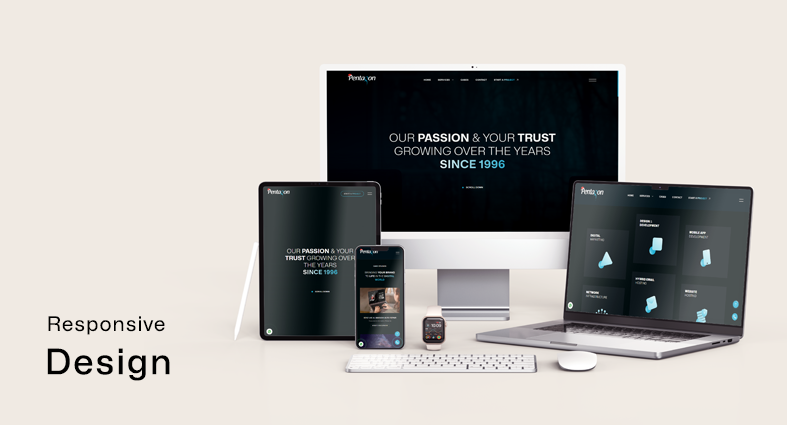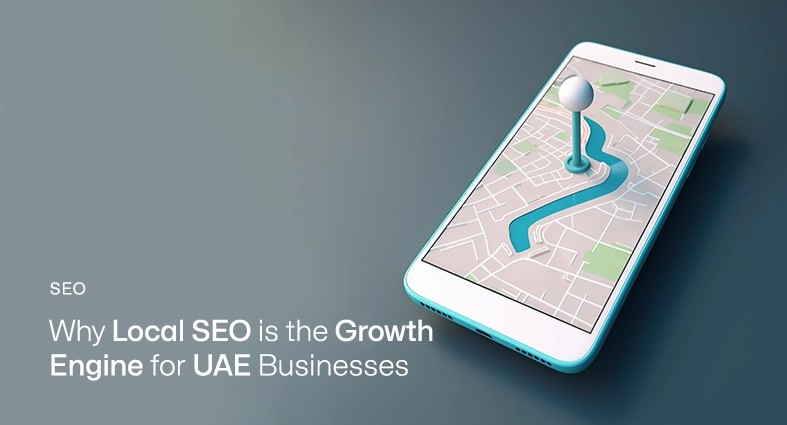In the highly competitive online landscape of Abu Dhabi, the success of a website depends not only on its visual appeal but also on the experience it provides to its users. User experience (UX) design plays a pivotal role in shaping the interaction between a website and its visitors, influencing engagement, conversions, and overall website performance. A well-crafted UX design can captivate users, keep them engaged, and guide them seamlessly through the website, while poor UX can lead to frustration, high bounce rates, and missed opportunities. This article explores the power of UX design and its impact on Abu Dhabi websites, highlighting the crucial role it plays in enhancing user engagement, reducing bounce rates, and improving search engine rankings. By understanding and implementing effective UX strategies, businesses in Abu Dhabi can unleash the full potential of their websites, captivating audiences, and achieving online success.
What is User Experience (UX)?
User Experience (UX) refers to the overall experience that a user has when interacting with a website or digital product. It encompasses the emotions, perceptions, and responses that users have while navigating through a website. UX design focuses on creating a positive and intuitive experience for users by considering their needs, goals, and preferences. UX design incorporates various elements to ensure a seamless and enjoyable user experience. These elements include usability, accessibility, and interaction design. Usability refers to the ease of use and efficiency of a website, ensuring that users can accomplish tasks and find information easily. Accessibility focuses on making websites inclusive and available to users of all abilities, ensuring that individuals with disabilities can navigate and interact with the site. Interaction design focuses on designing interactive elements such as buttons, menus, and forms to facilitate user engagement and interaction.
The Role of UX in Website Success
UX design plays a pivotal role in the success of a website. A well-designed user experience can have a significant impact on user engagement, conversion rates, and customer satisfaction. Here’s how UX contributes to website success:
- User Engagement: A well-designed UX captivates users, encouraging them to spend more time on the website. Engaging experiences with intuitive navigation, visually appealing design, and interactive elements can keep users interested and immersed in the content.
- Conversion Rates: UX design directly influences the conversion rates of a website. By creating clear and persuasive user flows, strategically placing call-to-action buttons, and streamlining the checkout process, UX design can guide users towards desired actions, such as making a purchase or filling out a contact form.
- Customer Satisfaction: A positive user experience enhances customer satisfaction and fosters positive brand associations. When users have a seamless and enjoyable experience on a website, they are more likely to have a favorable perception of the brand and develop trust and loyalty towards it.
- Brand Credibility: A well-crafted UX design reflects professionalism and attention to detail, instilling confidence in users and building brand credibility. A website that is easy to navigate, visually appealing, and user-friendly signals to visitors that the brand is reliable and trustworthy.
- User Retention: A positive user experience encourages users to return to a website, increasing user retention. When users have a satisfying experience, they are more likely to revisit the site, explore additional products or services, and potentially become repeat customers.
Impact of UX on user engagement and website performance
When users have a positive experience on a website, they are more likely to engage with the content, spend more time exploring the offerings, and take desired actions such as making a purchase or submitting a form. On the other hand, poor UX can lead to high bounce rates, frustrated visitors, and missed opportunities for conversions. Research has shown that users are more likely to abandon a website if they encounter difficulty in finding information, experience slow load times, or encounter confusing navigation. Beyond user engagement, UX design also has a direct impact on website performance in search engine rankings. Major search engines like Google consider various UX signals when determining the relevance and quality of a website. Factors such as page load speed, mobile-friendliness, and user behavior metrics like dwell time are all taken into account. Websites with exceptional UX tend to have lower bounce rates and longer dwell times, signaling to search engines that the content is valuable and engaging. As a result, these websites are more likely to rank higher in search engine results, attracting more organic traffic and potential customers.
The importance of UX design goes beyond aesthetics and functionality. It is about understanding the needs, preferences, and behaviors of the target audience and aligning them with the goals of the business. By investing in UX design, businesses in Abu Dhabi can create websites that not only attract and retain visitors but also drive conversions, increase customer satisfaction, and ultimately achieve online success. In the following sections, we will delve into the key elements and strategies of UX design that can make a significant impact on the performance and success of websites in Abu Dhabi.
Elements of Effective UX Design
Effective UX design encompasses several key elements that work together to create a seamless and engaging user experience. First and foremost, user research and analysis play a vital role in understanding the target audience’s needs, preferences, and pain points. By conducting thorough research, businesses can gain valuable insights that inform design decisions and ensure the website meets users’ expectations. Information architecture and navigation are also crucial aspects of UX design, as they determine how content is organized and how users navigate through the website. A well-structured and intuitive information architecture helps users find what they need quickly and easily, enhancing their overall experience. Responsive and mobile-friendly design is essential in today’s mobile-driven world, ensuring that the website adapts and functions seamlessly across different devices and screen sizes. Visual design and branding elements, such as color schemes, typography, and imagery, contribute to creating a visually appealing and cohesive user interface that aligns with the brand identity. Usability and accessibility are fundamental considerations as well, ensuring that the website is easy to use, intuitive, and inclusive for all users, including those with disabilities. By focusing on these elements of effective UX design, businesses can enhance user engagement, improve conversion rates, and establish a positive online presence.
User Research and Analysis
User research and analysis are fundamental steps in creating a successful user experience (UX) design. By conducting thorough research, web designers gain valuable insights into the target audience’s needs, preferences, and behaviors. This information guides the decision-making process and helps designers create a website that resonates with users. User research involves various methods, such as surveys, interviews, and user testing. These techniques enable designers to gather data on user demographics, motivations, pain points, and expectations. By understanding the target audience, designers can tailor the website’s design and content to meet their specific needs. Analyzing user behavior and feedback is equally important. By tracking user interactions, heatmaps, and conversion funnels, designers can identify patterns and make informed design decisions. User feedback, obtained through surveys or feedback forms, provides valuable insights into areas that need improvement or adjustment.
Information Architecture and Navigation
Information architecture and navigation play a crucial role in delivering an intuitive and user-friendly experience. A well-organized website structure enables users to find information easily and navigate through the site seamlessly. To create effective information architecture, designers must carefully categorize and label the website’s content. This involves organizing content into logical sections and hierarchies, creating clear and concise menus, and implementing search functionality. By doing so, users can quickly locate the information they need without feeling overwhelmed or confused. Intuitive navigation ensures that users can move effortlessly between different sections of the website. This includes providing clear and consistent navigation menus, incorporating breadcrumbs for easy tracking of the user’s location, and utilizing contextual links to guide users to related content. A streamlined navigation experience reduces user frustration and encourages them to explore more of the website.
Responsive and Mobile-Friendly Design
With the increasing use of mobile devices, responsive design has become a crucial aspect of UX design. Responsive design ensures that websites adapt and display properly on various devices and screen sizes, including smartphones and tablets. A responsive design approach involves using flexible layouts, proportion-based grids, and media queries to adjust the website’s appearance and functionality according to the device being used. This allows users to have a consistent and optimized experience, regardless of the device they choose to access the website. Optimizing websites for mobile devices is essential due to the growing number of users accessing the internet on their smartphones. Mobile-friendly design principles, such as touch-friendly buttons, legible fonts, and streamlined forms, enhance usability and convenience for mobile users. By providing a seamless mobile experience, businesses can reach and engage a larger audience.
Usability and Accessibility
Usability and accessibility are key considerations in UX design to ensure that the website is user-friendly and inclusive. Usability focuses on creating a website that is easy to navigate, understand, and interact with. This involves placing important information prominently, using clear and concise language, and providing intuitive user interfaces. Designers should also pay attention to the placement and design of calls-to-action (CTAs) to guide users toward desired actions. Accessibility aims to make websites accessible to users with disabilities or impairments. Designers should consider factors such as screen reader compatibility, color contrast for visually impaired users, and keyboard navigation for users who cannot use a mouse. By implementing accessibility features, websites become more inclusive, providing equal access and usability for all users.
UX Design for Engagement and Conversion
When it comes to website success, user engagement, and conversion rates are key metrics to consider. UX design plays a vital role in creating a seamless and enjoyable user experience that leads to increased engagement and higher conversion rates. Clear and intuitive user flows guide visitors through the website, making it easy for them to find what they are looking for and take desired actions. Effective call-to-action (CTA) placement strategically prompts users to take specific actions, whether it’s making a purchase, subscribing to a newsletter, or filling out a contact form. A streamlined checkout process minimizes friction and increases the likelihood of completing a purchase, reducing cart abandonment rates. By focusing on UX design principles, such as intuitive navigation, compelling CTAs, and a user-friendly checkout process, businesses can optimize their websites for maximum engagement and conversion success.
Clear and Intuitive User Flows
User flows play a vital role in guiding website visitors toward desired actions and conversions. When designing user flows, it is important to analyze user behavior and understand their journey on the website. By mapping out the steps users take to complete specific tasks or reach specific goals, businesses can identify potential obstacles or points of friction and optimize the user experience accordingly. By minimizing friction and streamlining the user journey, businesses can increase the likelihood of conversions and improve overall engagement.
Effective Call-to-Action (CTA) Placement
Strategic placement of call-to-action (CTA) buttons is crucial for driving user actions and conversions. CTAs should be placed in prominent and easily accessible positions within the user interface. It is important to utilize compelling copy and design elements that capture attention and create a sense of urgency. The language used in CTAs should be clear, concise, and action-oriented, encouraging users to take the desired action. Effective CTAs can lead to increased click-through rates, higher conversion rates, and improved user engagement.
Streamlined Checkout Process
For e-commerce websites, the checkout process is a critical stage where users make their final purchase decisions. Optimizing the checkout process is essential for reducing cart abandonment rates and increasing conversions. To streamline the checkout process, businesses should focus on simplifying form fields, minimizing the number of steps required to complete the purchase, and providing clear progress indicators. Offering multiple payment options and ensuring secure transactions also instills trust and confidence in users, leading to a smoother checkout experience. A well-designed and streamlined checkout process can significantly improve conversion rates and contribute to a positive user experience.
The Impact of UX on Search Engine Rankings
Search engine optimization (SEO) is a critical aspect of ensuring a website’s visibility and organic traffic. In recent years, search engines like Google have increasingly emphasized the importance of user experience (UX) in their ranking algorithms. By providing a positive UX, websites can not only satisfy visitors but also improve their search engine rankings.
User Experience Signals in SEO
Search engines consider various UX signals when determining the relevance and quality of a website. Three essential UX signals that impact search engine rankings are:
- Page Load Speed: A fast-loading website enhances user satisfaction and improves the overall user experience. Search engines prioritize websites that load quickly because they provide a smoother browsing experience.
- Mobile-Friendliness: With the increasing use of mobile devices for browsing, search engines give preference to websites that are optimized for mobile devices. Mobile-friendliness ensures that websites adapt to different screen sizes, providing a seamless browsing experience for mobile users. Responsive design, which allows the website to adjust its layout based on the user’s device, is a key factor in improving mobile-friendliness. Websites that are not mobile-friendly may experience higher bounce rates and lower engagement, leading to lower search engine rankings.
- Dwell Time: The amount of time a user spends on a website before returning to search results, is another significant user experience signal. A well-designed user experience can encourage visitors to stay on a website longer, exploring its content and engaging with its features. Longer dwell time indicates that users find the website valuable and relevant to their search queries. Search engines interpret longer dwell time as a positive signal and may reward the website with higher rankings. To increase dwell time, websites can focus on providing relevant and engaging content, improving navigation and usability, and optimizing the overall user experience.
Reduced Bounce Rates and Improved Dwell Time
A well-designed user experience can significantly impact bounce rates and dwell time, both of which have a direct influence on search engine rankings. High bounce rates indicate that users are not finding what they are looking for or are dissatisfied with the web site’s content or usability. Search engines interpret high bounce rates as a signal of poor user experience and may lower the website’s rankings as a result. By focusing on improving the user experience, websites can effectively reduce bounce rates. Clear and intuitive navigation, compelling content, and an aesthetically pleasing design can captivate users and encourage them to explore the website further. Engaging visuals, easy-to-read content, and relevant internal linking can also entice visitors to navigate to other pages, reducing bounce rates and increasing the likelihood of conversions.
The Role of a Web Design Agency in UX Design
A web design agency plays a critical role in the success of UX design for websites in Abu Dhabi. These agencies have the expertise and knowledge to create optimal user experiences by focusing on various elements of UX design. They collaborate with businesses to understand their target audience through user research and analysis, ensuring that the website caters to their needs and preferences. Web design agencies excel in crafting intuitive information architecture and navigation, enabling users to easily access and navigate through the website’s content. They also prioritize responsive and mobile-friendly design, ensuring seamless user experiences across devices and catering to the increasing mobile traffic. Additionally, these agencies emphasize visual design and branding, incorporating visually appealing and consistent elements that align with the brand identity and evoke positive emotions. Usability and accessibility are also key considerations, as web design agencies strive to create websites that are easy to use, navigate, and accommodate users with disabilities. By collaborating with a web design agency in Abu Dhabi, businesses can leverage their expertise in UX research, design best practices, and cutting-edge tools to create engaging, conversion-driven online experiences that align with their business goals and enhance customer satisfaction.
Collaborating with a Web Design Agency
When it comes to achieving a seamless user experience (UX) for your website, partnering with a professional web design agency in Abu Dhabi can be a game-changer.
- Specialization in Optimal User Experiences: Web design agencies specialize in creating websites that prioritize user experience. They understand the importance of designing interfaces that are intuitive, visually appealing, and easy to navigate. By leveraging their expertise, they can help you create an engaging website that aligns with your business goals and effectively connects with your target audience.
- Access to a Multidisciplinary Team: Web design agencies have a dedicated team of professionals with diverse skill sets. From UX designers to researchers, developers to content strategists, agencies bring together experts from various fields to ensure all aspects of UX design are covered. This multidisciplinary approach allows for a comprehensive and well-rounded UX strategy.
- Knowledge and Tools for UX Research and Analysis: Conducting user research and analysis is a crucial aspect of UX design. Web design agencies have the knowledge and tools to gather valuable insights about your target audience. Through techniques such as user interviews, surveys, and usability testing, they can uncover user needs, behaviors, and pain points. This information serves as a foundation for creating user-centric design solutions.
- Implementation of UX Best Practices: Web design agencies stay up to date with the latest UX trends and best practices. They have a deep understanding of how users interact with websites and can implement strategies that enhance usability, accessibility, and engagement. From responsive design for mobile optimization to intuitive information architecture, agencies apply industry-proven techniques to ensure an exceptional user experience.
Expertise in UX Research and Design
Web design agencies have the necessary expertise and tools to conduct in-depth user research and analysis. They employ various research techniques, such as user interviews, surveys, and usability testing, to gain insights into user preferences, expectations, and pain points. This research-driven approach allows them to design UX solutions that are tailored to your target audience’s needs. Web design agencies have a deep understanding of UX best practices and industry standards. They stay up to date with the latest trends and advancements in UX design, ensuring that your website incorporates the most effective techniques for enhancing user engagement and satisfaction. Whether it’s implementing intuitive navigation, creating clear call-to-action buttons, or optimizing page load speed, they know to make informed design decisions that positively impact the overall user experience.
Web design agencies possess the necessary design skills and technical expertise to create effective UX solutions. They are proficient in utilizing various design tools and technologies to transform user research and insights into visually appealing and functional interfaces. From wireframing and prototyping to user testing and iteration, they follow a systematic design process to deliver a website with exceptional UX.
Conclusion
The power of user experience (UX) design cannot be underestimated when it comes to the success of websites in Abu Dhabi. A well-designed UX can significantly impact user engagement, reduce bounce rates, and improve search engine rankings. By prioritizing UX design, businesses in Abu Dhabi can create websites that provide seamless and enjoyable experiences for their visitors. This not only leads to higher user satisfaction and increased engagement but also drives conversions and boosts the overall performance of the website. Investing in UX design is an essential step for businesses in Abu Dhabi to stand out in the competitive online market, attract and retain visitors, and ultimately achieve their online goals. By understanding the importance of UX and implementing effective design strategies, businesses can unlock the full potential of their websites and create a powerful online presence in Abu Dhabi. Transform Your Online Presence Today with Pentagon’s Expert Web Design Services. Take Your Website to the Next Level and Captivate Your Audience. Get in Touch Now!
services
Feel free to send us a message.
Please, share your thoughts, and let's chat over a cup of tea.


















